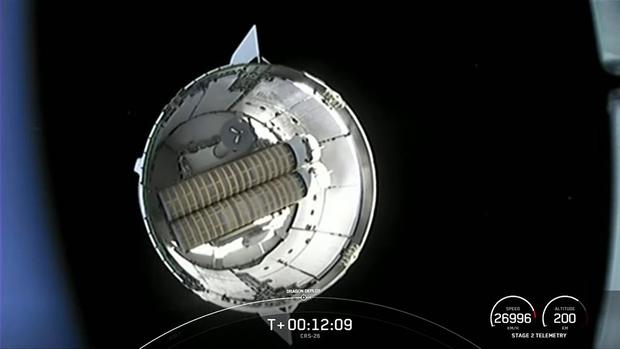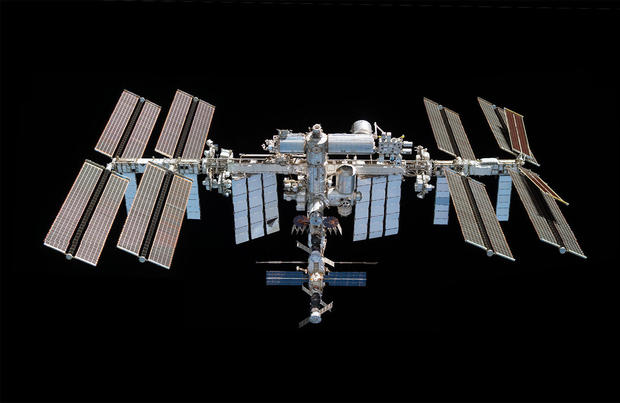SpaceX sends supplies to space station in 54th launch this year
NASA TV
SpaceX launched its 26th space station resupply mission Saturday, sending up 7,700 pounds of equipment and supplies aboard a Dragon cargo ship, including belated Thanksgiving Day treats for the lab’s crew, research gear and two new roll-out solar arrays to boost the station’s power.
Running late because of stormy weather earlier this week, the Falcon 9 rocket’s first-stage engines roared to life at 2:20 p.m. EST and the slender rocket shot away from pad 39A at the Kennedy Space Center. About 12 minutes later, the Cargo Dragon was released to fly on its own.
If all goes well, the spacecraft will chase down the station early Sunday, approaching from behind and below. After looping up in front of the lab and then above it, the capsule will move in for an autonomous docking at the space-facing port of the forward Harmony module.
“Of critical importance to us (are) the two new solar arrays that we’ll be doing spacewalks … to install and deploy on board the International Space Station,” said Joel Montalbano, space station program manager at the Johnson Space Center in Houston.
“And in addition to the two solar arrays, we have some life support equipment being delivered, some GPS hardware, some exercise hardware and some medical equipment. … All in all, we’re looking for an exciting mission.”
Also on board: belated Thanksgiving treats for the station’s seven-member crew, including spicy green beans, cranapple desserts and pumpkin pie.
“In addition, our standard food menu allows them to have everything that we’d be having on Thanksgiving, you know, mashed potatoes, candied yams, mac and cheese for those who want mac and cheese. So we’re going to get those guys fed very well.”
The Cargo Dragon also is loaded with research gear, including an experiment to grow dwarf tomatoes in space, an experimental in-flight medical diagnosis kit, an experiment to test novel techniques for building large structures in microgravity and another that will test new ways to produce key nutrients in space.
NASA TV
The ISS Roll-Out Solar Arrays, or IROSAs, are the third and fourth of six being installed on the space station in a $103 million upgrade to augment the power output of the lab’s eight older, original-equipment blankets.
The space station was built with four huge rotating solar wings, two on the right side of the lab and two on the left. Each of those four wings is made up of two solar blankets extending from opposite sides of a central hub.
The first pair of original-equipment blankets have been in operation for more than 20 years. Subsequent wings were added in 2006, 2007 and 2009. All of them have suffered degradation from years in the space environment and they do not generate as much power as they did when they were new.
The IROSA blankets, about half the size of the original arrays, are more efficient and will eventually generate an additional 120 kilowatts of power. They were designed to be mounted on brackets at the base of an existing wing, extending outward at a 10-degree angle to minimize the shade they cast on the array below.
NASA
The first two IROSA blankets were installed on the left-side outboard arrays — the oldest set on the station — during spacewalks in 2021. The IROSAs carried up aboard the SpaceX Cargo Dragon Saturday will be installed on the left and right-side inboard wings during spacewalks in December.
“The first two arrays have been performing outstandingly well,” Matt Mickle, development projects senior manager at Boeing, said in a NASA release. “The solar cells are immensely more powerful than previous generations.”
Once all six roll-out arrays are installed, overall power generation will be boosted 20 to 30 percent, roughly matching the output of the original arrays when they were new.
The final two of the six IROSAs currently under contract will be launched next year. It’s not yet known whether NASA will buy two final IROSAs to augment all eight of the station’s original blankets.
For all the latest Entertainment News Click Here
For the latest news and updates, follow us on Google News.





